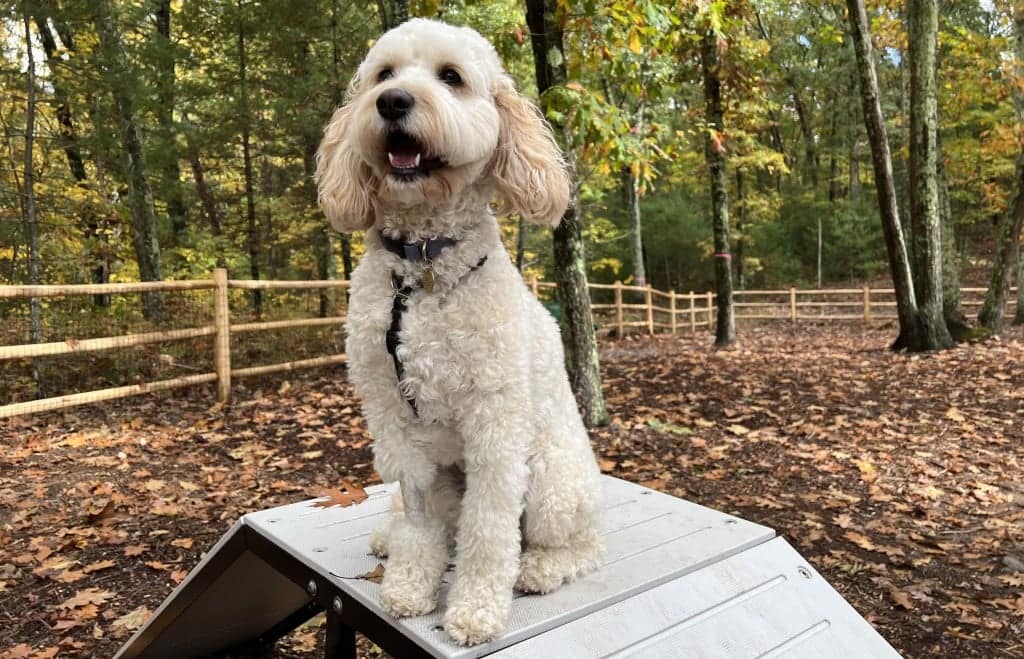A thoughtfully designed dog park is more than just a space to let dogs off leash. It’s a vibrant community hub that promotes health, happiness, and social connections for pets and their humans.
Whether you’re designing a brand-new park or upgrading an existing one, there are key elements that make a dog park truly paw-some.
At Premier Park & Play, we know that the right dog park equipment and smart planning can turn a simple space into a beloved destination. Ready to unleash your design potential? Here’s how to lay the groundwork:
1. 🗣️ Seek Community Input from the Get-Go for Your Paw-ject!
Involve your local community early in the design process. Hosting informational forums and neighborhood meetings helps ensure the final park reflects the needs and preferences of local dog owners and builds excitement and ownership along the way.
🎉 Raise Capital Through Events and Activities
Fundraising can be fun! Organize events like:
- Doggie playdates
- Pet adoption events
- Training seminars for owners
According to the National Recreation and Park Association, community events like these strengthen social bonds and promote responsible pet ownership – key goals for any successful park.
2. 🐾 Promote Health and Safety
A great dog park keeps tails wagging and ensures safety for every user.
Let’s start with the essentials:
✅ Safe Materials on Equipment
Choose equipment that follows American Kennel Club (AKC) guidelines to ensure durability, safety, and canine-friendly design. Recently, one of our manufacturers has introduced a new line of recycled dog park elements that are both engaging for pets and environmentally friendly.
📏 Proper Sizing in Play Areas
Separate areas for large and small dogs are crucial to prevent accidents and avoid mismatched play. Match the equipment sizing to each group for safer, more inclusive fun. Commonly you will see an area for large dogs and an area for smaller dogs separated by fencing.
Include large, open areas where dogs and owners can run, fetch, and explore freely. This supports cardiovascular fitness and makes the park a go-to spot for daily exercise.
This kind of setup encourages joint activity, healthy habits, and even a bit of friendly competition.
🌱 Proper Surfaces
The ground surface matters! Choose materials that:
- Are gentle on paws
- Offer traction and cushioning
- Withstand heavy use and weather
Natural turf, turf-mulch blends, or dog-friendly synthetic grass are all great options. Consider K-9 turf which features disinfectant properties and is perfect for this type of setting.
💦 Water Sources
Keep dogs cool and hydrated:
- Add dog-friendly splash pads or ponds for play and temperature control
- Include dog-specific water fountains that are easy to use and at the right height.
3. 🤝 Encourage Participation with Human–Canine Specific Exercise Equipment
Why let the dogs have all the fun? A park designed for both dogs and their humans promotes bonding, fitness, and fun.
🏋️♀️ Human-Canine Shared Fitness Zones
Take it a step further with dual-purpose equipment.
- Parallel bars for humans alongside tunnels for dogs
- Stretch stations next to dog hurdles
4. 🐶 Design Play for Dog Interaction and Relationship-Building
Incorporate thoughtfully placed play features that promote healthy dog interaction helps pups learn social cues. This reduces anxiety and builds confidence over time.
🐾 Social Play Structures
- Weave Poles – Encourage dogs to take turns or follow one another through a playful course
- Dog Bridges or Balance Beams – Dogs meet mid-bridge and learn body language cues. Elevated platforms encourage shared space and curiosity.
- Doggy Crawl Spaces – Dogs crawl under or around each other and invite interaction
in close proximity. Helps build trust and encourages calm movement. - Interactive Play Panels (with Scent or Sound Features) – Panels with built-in scent dispensers or textures can draw multiple dogs at once. Group sniffing and sensory experiences are natural bonding tools.
- Fetch Zones with Shared Toys or Ball Launchers – Encourages group play and social chasing.
- Climbing Mounds or Dog Hills – Dogs engage in chase and climbing games. Builds confidence between dogs of different sizes and energy levels.
5. 🪑Make the Dog Park a Destination All Can Enjoy
Dog owners need places to rest, relax, and socialize while their pets play. Consider shade elements along with benches and tables to make the dog park somewhere everyone wants to hang out.
💪 Durable Materials
Use eco-friendly, weather-resistant materials like recycled plastic or coated steel to ensure longevity and comfort in all conditions.
🧼 Low-Maintenance Options
Choose easy-to-clean designs, like smooth or slatted benches that dry quickly and resist dirt buildup. This keeps the park looking great with minimal upkeep.
6. 🐶 Choose Other Considerations for a Successful Dog Park
It’s the small details that turn a good park into a great one.
Install ample waste bag dispensers and bins throughout the park to encourage responsible cleanup and maintain a pleasant, hygienic environment.
🧱 Secure Boundaries
Use secure fencing and dog-proof gates to keep dogs safe. Also, make sure to avoid toxic plants or harmful landscaping materials.
🐕 Plan Smart for a Pawsitive Impact!
Designing a dog park is about creating a space where dogs can thrive, owners can connect, and the community can grow stronger. With smart, thoughtful planning and durable, low-maintenance equipment, your dog park can become a cherished local landmark.
From fitness zones to shaded seating, agility courses to splash pads, every detail contributes to a safe, active, and social space.

